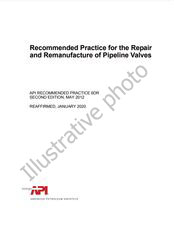We need your consent to use the individual data so that you can see information about your interests, among other things. Click "OK" to give your consent.

API PUBL 346-ed.1998
Results of Range-Finding Testing of Leak Detection and Leak Location Technologies for Underground Pipelines
Translate name
STANDARD published on 1.11.1998
The information about the standard:
Designation standards: API PUBL 346-ed.1998
Publication date standards: 1.11.1998
SKU: NS-1139734
The number of pages: 239
Approximate weight : 748 g (1.65 lbs)
Country: American technical standard
Category: Technical standards API
Annotation of standard text API PUBL 346-ed.1998 :
API PUBL 346, 1998 Edition, November 1998 - Results of Range-Finding Testing of Leak Detection and Leak Location Technologies for Underground Pipelines
SCOPE AND OBJECTIVES
The project objectives were to:
- • identify different technologies available for leak detection and location for the selected type of pipelines,
- • identify vendors of each technology,
- • select vendors for testing,
- • conduct range-finding tests of the technologies, and
- • assess potential impacts on operations.
The scope of the project was limited to range-finding tests; testing was not intended to provide a complete evaluation of any specific system. Rather, the objective was to identify technologies and obtain information on the performance of each technology, together with the field considerations or limitations for applying each.
GENERAL PROJECT OBJECTIVES
The project identified the different technologies available for leak detection and leak location for underground pipelines of the sort used at refineries, fuel terminals, airports, and transportation facilities. Four different technologies were identified and representative vendors of each were reviewed. Based on that review, a vendor of each technology was selected and invited to participate in field trials. The purpose of the field tests was to provide information on the state of the technology in terms of its suitability for use in the field and to provide and estimate each technologys sensitivity and accuracy in application.
SCOPE OF THE TESTING
The scope of the testing of each technology was designed to observe the operation of the technology and provide an approximate estimate of its performance. To this end, several features of each technology were documented as part of the testing:
- • The amount of and types of equipment employed
- • The time for setup and calibration (if necessary)
- • The site support and preparation required
- • General operational considerations
- • Impact on operations
- • Test procedures
- • Test duration
- • Test results for tight lines and for simulated leaks
- • Leak location results (when applicable)
Testing was conducted with different lengths of lines and with different simulated leak rates. Testing was conducted at an operating site, which included one line with a suspected leak and another line with a known substantial leak as well as two lines of different sizes that were supposed to be tight. Thus, the tests included both real leaks and simulated leaks and different length of lines, providing different volumes of product in the lines.
The vendors were provided with a description of the facility, including a sketch of the configuration of the lines. The approximate length of each identified segment was provided as well as the diameter and, when applicable, the number of hydrants. The vendors were told that the lines would be taken out of service and isolated from the rest of the system by blind flanges so that there would be no question about possible leakage past valves into other sections of the pipeline. MRI told the vendors that they were being asked to test each section of line as a commercial test and report the results. Vendors were told that all work performed would be considered their typical commercial protocol. If the vendors identified a leak in the lines as they found them, and had the capability of locating the leak, they would be asked to locate the leak.
MRI also told the vendors that they would be asked to test each line multiple times. MRI would simulate a number of leaks of various sizes during some of the testing and would ask the vendors to conduct a number of tests under both tight and simulated leak conditions. The simulated leak rates would be kept blind to the vendors.
We recommend:
Updating of laws
Do you want to be sure about the validity of used regulations?
We offer you a solution so that you could use valid and updated legislative regulations.
Would you like to get more information? Look at this page.



 Cookies
Cookies
